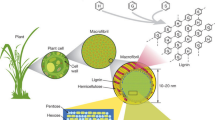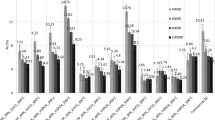Abstract
Pyrolysis characteristics and kinetics of sour cherry stalk and flesh were investigated using non-isothermal thermogravimetric analysis at five different heating rates of 5, 10, 20, 30 and 40 °C min−1. Activation energies at two different particle size ranges were determined from the experimental data using various isoconversional methods, namely Friedman, Flynn–Wall–Ozawa and Kissinger–Akahira–Sunose methods. Four stages were observed during the pyrolysis process in which the second and the third stage were determined as active decomposition stages. Average activation energies of sour cherry stalk with a particle size of 75–150 µm were calculated in the range of 159.0–160.5 kJ mol−1 and 118.8–141.1 kJ mol−1 at the second and the third active stage, respectively. The same type of biomass with a particle size of 150–250 µm revealed average activation energies in the range of 179.7–180.0 kJ mol−1 and 162.1–164.6 kJ mol−1 at the second and the third active stage, respectively. Average activation energies of sour cherry flesh with a particle size of 75–150 µm were calculated in the range of 136.2–160.5 kJ mol−1 and 133.7–151.2 kJ mol−1 at the second and the third active stage, respectively. The same type of biomass with a particle size of 150–250 µm resulted in average activation energies in the range of 266.1–273.9 kJ mol−1 and 179.8–197.8 kJ mol−1 at the second and the third active stage, respectively. Besides the obtained activation energy values, results demonstrated the effect of the particle size of the applied biomass on pyrolysis kinetics as well as the possibility of using sour cherry stalk and flesh as renewable feedstock for alternative energy source.









Similar content being viewed by others
References
Wu K, Liu J, Wu Y, et al. Pyrolysis characteristics and kinetics of aquatic biomass using thermogravimetric analyzer. Bioresour Technol. 2014;163:18–25.
Fu S, Chen H, Yang J, et al. Kinetics of thermal pyrolysis of Eucalyptus bark by using thermogravimetric-Fourier transform infrared spectrometry technique. J Therm Anal Calorim. 2020;139:3527–35.
Açıkalın K. Pyrolytic characteristics and kinetics of pistachio shell by thermogravimetric analysis. J Therm Anal Calorim. 2012;109:227–35.
Shah MA, Khan MNS, Kumar V. Biomass residue characterization for their potential application as biofuels. J Therm Anal Calorim. 2018;134:2137–45.
Ghosh SK. Biomass & bio-waste supply chain sustainability for bio-energy and bio-fuel production. Procedia Environ Sci. 2016;31:31–9.
Sharma A, Pareek V, Zhang D. Biomass pyrolysis: a review of modelling, process parameters and catalytic studies. Renew Sust Energy Rev. 2015;50:1081–96.
Açıkalın K, Karaca F. Fixed-bed pyrolysis of walnut shell: parameter effects on yields and characterization of products. J Anal Appl Pyrolysis. 2017;125:234–42.
Hu Z, Chen Z, Li G, et al. Characteristics and kinetic studies of Hydrilla verticillata pyrolysis via thermogravimetric analysis. Bioresour Technol. 2015;194:364–72.
Soria-Verdugo A, Goos E, García-Hernando N, et al. Analysis the pyrolysis kinetics of several microalgae species by various differential and integral isoconversional kinetic methods and Distributed Activation Energy Model. Algal Res. 2018;32:11–29.
Demirbaş A. Pyrolysis mechanisms of biomass materials. Energ Source Part A. 2009;31(13):1186–93.
Di Blasi C. Modelling chemical and physical processes of wood and biomass pyrolysis. Prog Energy Combust Sci. 2008;34:47–90.
Vimalathithan PK, Barile C, Vijayakumar CT. Investigation of kinetic triplets for thermal degradation of thermally cured vinyl ester resin systems and lifetime predictions. J Therm Anal Calorim. 2018;133:881–91.
Hu M, Chen Z, Wang S, et al. Thermogravimetric kinetics of lignocellulosic biomass slow pyrolysis using distributed activation energy model, Fraser-Suzuki deconvolution and iso-conversional method. Energy Convers Manage. 2016;118:1–11.
He Y, Chang C, Li P, et al. Thermal decomposition and kinetics of coal and fermented cornstalk using thermogravimetric analysis. Bioresour Technol. 2018;259:294–303.
Das P, Mondal D, Maiti S. Thermochemical conversion pathways of Kappaphycus alvarezii granules through study of kinetic models. Bioresour Technol. 2017;234:233–42.
Chen D, Shuang E, Liu L. Analysis of pyrolysis characteristics and kinetics of sweet sorghum bagasse and cotton stalk. J Therm Anal Calorim. 2018;131:1899–909.
Wojdylo A, Figiel A, Lech K, et al. Effect of convective and vacuum-microwave drying on the bioactive compounds, color, and antioxidant capacity of sour cherries. Food Bioprocess Technol. 2014;7:829–41.
FAO. Food and Agriculture Organization of the United Nations. 2016. http://faostat.fao.org. Accessed 21 Aug 2019.
Doymaz İ. Influence of pretreatment solution on the drying of sour cherry. J Food Eng. 2007;78:591–6.
Damar İ, Ekşi A. Antioxidant capacity and anthocyanin profile of sour cherry (Prunus cerasus L.) juice. Food Chem. 2012;135:2910–4.
Sun SY, Che CY, Sun TF, et al. Evaluation of sequential inoculation of Saccharomyces cerevisiae and Oenococcus oeni strains on the chemical and aromatic profiles of cherry wines. Food Chem. 2013;138(4):2233–41.
Duran-Valle CJ, Gomez-Corzo M, Gomez-Serrano V, et al. Preparation of charcoal from cherry stones. Appl Surf Sci. 2006;252:5957–60.
Olivares-Marin M, Fernandez-Gonzales C, Macias-Garcia A, et al. Preparation of activated carbons from cherry stones by activation with potassium hydroxide. Appl Surf Sci. 2006;252:5980–3.
Angin D. Production and characterization of activated carbon from sour cherry stones by zinc chloride. Fuel. 2014;115:804–11.
Gonzales JF, Encinar JM, Canito JL, et al. Pyrolysis of cherry stones: energy uses of the different fractions and kinetic study. J Anal Appl Pyrolysis. 2003;67:165–90.
Duman G, Okutucu C, Ucar S, et al. The slow and fast pyrolysis of cherry seed. Bioresour Technol. 2011;102:1869–78.
Alper K, Tekin K, Karagöz S. Pyrolysis of agricultural residues for bio-oil production. Clean Technol Environ. 2015;17:211–23.
Özsin G, Pütün AE. Kinetics and evolved gas analysis for pyrolysis of food processing wastes using TGA/MS/FT-IR. Waste Manag. 2017;64:315–26.
Korlesky NM, Stolp LJ, Kodali DR, et al. Extraction and characterization of Montmorency sour cherry (Prunus cerasus L.) pit oil. J Am Oil Chem Soc. 2016;93:995–1005.
Gillespie GD, Everard CD, Fagan CC, et al. Prediction of quality parameters of biomass pellets from proximate and ultimate analysis. Fuel. 2013;111:771–7.
Cruz G, Rodriguez ALP, Silva DF, et al. Physical-chemical characterization and thermal behavior of cassava harvest for application in thermochemical processes. J Therm Anal Calorim. 2020. https://doi.org/10.1007/s10973-020-09330-6.
Chandrasekaran A, Ramachandran S, Subbiah A. Determination of kinetic parameters in the pyrolysis operation and thermal behavior of Prosopis juliflora using thermogravimetric analysis. Bioresour Technol. 2017;233:413–22.
White JE, Catallo WJ, Legendre BL. Biomass pyrolysis kinetics: a comparative critical review with relevant agricultural residue case studies. J Anal Appl Pyrol. 2011;91:1–33.
Doyle CD. Estimating isothermal life from thermogravimetric data. J Appl Polym Sci. 1962;6:639–42.
Coats AW, Redfern JP. Kinetic parameters from thermogravimetric data. Nature. 1964;201:68–9.
Starink MJ. The determination of activation energy from linear heating rate experiments: a comparison of the accuracy of isoconversion methods. Thermochim Acta. 2003;404:163–76.
Friedman HL. Kinetics of thermal degradation of char-forming plastics from thermogravimetry. Application to a phenolic plastic. J Polym Sci Part C Polym Sympos. 1964;6(1):183–95.
Flynn J, Wall L. A quick, direct method for the determination of activation energy from thermogravimetric data. J Polym Sci Pol Lett. 1966;4:323–8.
Ozawa T. A new method of analyzing thermogravimetric data. Bull Chem Soc Jpn. 1965;38(11):1881–6.
Kissinger H. Variation of peak temperature with heating rate in differential thermal analysis. J Res Nat Bureau Stand. 1956;57(4):217–21.
Akahira T, Sunose T. Joint convention of four electrical institutes. Sci Technol. 1971;16:22–31.
García R, Pizarro C, Lavín AG, et al. Characterization of Spanish biomass wastes for energy use. Bioresour Technol. 2012;103:249–58.
McKendry P. Energy production from biomass (part 1): overview of biomass. Bioresour Technol. 2002;83:37–46.
Ceylan S, Topcu Y. Pyrolysis kinetics of hazelnut husk using thermogravimetric analysis. Bioresour Technol. 2014;156:182–8.
Yuakkul D, Amornsakchai T, Saikrasun S. Effect of maleated compatibilizer on anisotropic mechanical properties, thermo-oxidative stability and morphology of styrenic based thermoplastic elastomer reinforced with alkali-treated pineapple leaf fiber. Int J Plast Technol. 2015;19(2):388–411.
Brebu M, Cazacu G, Chirila O. Pyrolysis of lignin—a potential method for obtaining chemicals and/or fuels. Cell Chem Technol. 2011;45(1–2):43–50.
Lin X, Sui S, Tan S, et al. Fast pyrolysis of four lignins from different isolation processes using Py-GC/MS. Energies. 2015;8:5107–21.
Yang H, Yan R, Chen H, et al. Characteristics of hemicellulose, cellulose and lignin pyrolysis. Fuel. 2007;86:1781–8.
Lazaridis PA, Fotopoulos AP, Karakoulia SA, et al. Catalytic fast pyrolysis of kraft lignin with conventional, mesoporous and nanosized ZSM-5 zeolite for the production of alkyl-phenols and aromatics. Front Chem. 2018;6:295.
Li D, Briens C, Berruti F. Improved lignin pyrolysis for phenolics production in a bubbling bed reactor—effect of bed materials. Bioresour Technol. 2015;189:7–14.
Açıkalın K. Thermogravimetric analysis of walnut shell as pyrolysis feedstock. J Therm Anal Calorim. 2011;105:145–50.
Gogoi M, Konwar K, Bhuyan N, et al. Assessments of pyrolysis kinetics and mechanisms of biomass residues using thermogravimetry. Bioresour Technol Rep. 2018;4:40–9.
Alvarenga LM, Xavier TP, Barrozo MAS, et al. Determination of activation energy of pyrolysis of carton packaging wastes and its pure components using thermogravimetry. Waste Manag. 2016;53:68–75.
Alias NB, Ibrahim N, Hamid MKA. Pyrolysis of empty fruit bunch by thermogravimetric analysis. Energy Procedia. 2014;61:2532–6.
Pandey MP, Kim CS. Lignin depolymerization and conversion: a review of thermochemical methods. Chem Eng Technol. 2011;34(1):29–41.
He Z, Xia Z, Hu J, et al. Thermal decomposition and kinetics of electrically controlled solid propellant through thermogravimetric analysis. J Therm Anal Calorim. 2020;139:2187–95.
Liu H, Wang C, Zhao W, et al. Pyrolysis characteristics and kinetic modeling of Artemisia apiacea by thermogravimetric analysis. J Therm Anal Calorim. 2018;131:1783–92.
Acknowledgements
The authors would like to thank to The Scientific Research Project Coordination Unit of Yalova University (Project No. 2018/AP/0017) for the financial support and to DİMES Fruit Juice Company (İzmir, Turkey) for the supply of the biomass materials.
Author information
Authors and Affiliations
Corresponding author
Ethics declarations
Conflict of interest
The authors declare that they have no conflict of interest.
Additional information
Publisher's Note
Springer Nature remains neutral with regard to jurisdictional claims in published maps and institutional affiliations.
Rights and permissions
About this article
Cite this article
Gözke, G., Açıkalın, K. Pyrolysis characteristics and kinetics of sour cherry stalk and flesh via thermogravimetric analysis using isoconversional methods. J Therm Anal Calorim 146, 893–910 (2021). https://doi.org/10.1007/s10973-020-10055-9
Received:
Accepted:
Published:
Issue Date:
DOI: https://doi.org/10.1007/s10973-020-10055-9




